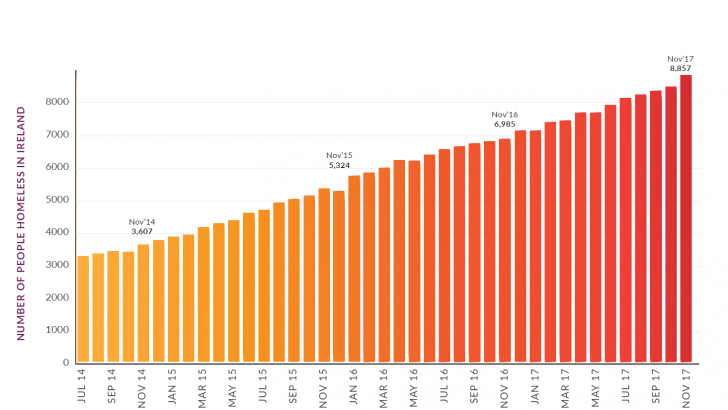Jonathan Corrie’s death in December 2014 seemed set to transform national attitudes to homelessness, but more than three years later, not merely has the situation not improved, but things have got much worse.
With roughly 9,000 people homeless in Ireland now, it seems the country now has more than twice as many people homeless as it did when then-minister Alan Kelly declared his intention to eradicate homelessness by the end of 2016.
Fr Peter McVerry seems thoroughly vindicated now in his dismissal of this claim as “Alice in Wonderland politics”, with Bro. Kevin Crowley of Dublin’s Capuchin Day Centre angrily declaring as 2016 drew to a close that poverty levels in the capital in the year that marked the centenary of the Easter Rising rivalled those of a century earlier.
The seemingly inexorable rise in homelessness comes despite minister after minister declaring that the Government was making the national homelessness crisis a priority. Fine words, of course, and strategic plan after strategic plan has clearly been well meant, but to date the Government’s record has been dismal in hitting its targets for completing rapid-build schemes, acquiring vacant properties, or increasing the number of social housing units in general.
Over the last three years homelessness campaigners have welcomed how awareness of the problem has increased, while time and again expressing frustration with Government failures to tackle the structural causes of homelessness, whether by increasing housing supply, raising rent supplements or introducing rent controls, or safeguarding tenants’ rights in cases when landlords decide to sell properties or use them for family members.
Immigration
While some have sought to blame immigration for the rise in homelessness, the reality is that the heart of the problem lies in the fundamentally dysfunctional nature of Ireland’s post-crash private rental market, with Central Bank lending rules making it impossible for professionals to get mortgages to buy homes, leaving them trapped in rental arrangements paying exorbitant rents that leave them incapable of saving towards ownership.
With 8,857 people known to have been homeless in the country in November, the real homeless figure will be significantly higher now if the pattern of recent years is repeated. The weeks after Christmas invariably see a spike in Ireland’s homelessness figures: landlords who had refrained from evicting tenants before Christmas issue notices to quit after the festive season, while otherwise homeless families who stayed with relations or friends over Christmas turn to homeless charities for help.
Homeless people tend to be at the forefront of people’s minds over Christmas, whether because of the constant reminders from charities, the increasingly bitter weather, or the implications of the Christmas story and the child who was born in a stable because there was no room in the inn, but January is a different matter, and with homelessness set to spike again, there could hardly be a worse time for the homeless to fall off the national radar.
In an attempt to keep the spotlight on this national tragedy, The Irish Catholic will be running a series of features in coming weeks addressing the homeless crisis.
Next week sees Focus Ireland exploring family homelessness against a background of the number of homeless families in Ireland rising from 396 to 1,530 in the three years to last November, while the following week DePaul will address the issue of youth homelessness, with the number of young people between 18 and 24 having almost doubled from 456 to 845 in the same period.


 Greg Daly
Greg Daly
